OTAVALO, ECUADOR - This Latin America beauty is so much more than the Galapagos and Quito. Though both these destinations are bucket list-worthy, I chose instead to explore a region two hours north of the capital city in the Andean province of Imbabura. My decision was not based on my radical sense of adventure — I’m a city gal at heart — but on the recommendation of a friend who built a house on an inactive volcanic mountain above the town of Otavalo and wouldn’t stop singing its praises. I had to see for myself, and was happy I did. It’s not a luxury destination — for sure — but the overall experience is both rugged and sublime.
Otavalo is described as a land of perpetual spring. With an elevation of just over 3,000 metres, and located between three volcanoes —Imbabura (4,630 metres), Cotacachi (4,995 metres) and Mojanda (4,263 metres) —the weather is never too hot or too cold.
For centuries, Otavalo’s market has played an important role in the region due to its location as a crossroads in the Andes, making it the cultural and trading heart of Ecuador’s vibrant Quechua community, famed for skills in weaving, woodworking, leatherwork and embroidery.
Travellers today might be familiar with what is known as the Saturday Market, said to be the largest indigenous market in all of Latin America. Artisans from surrounding villages journey to the Plaza de los Ponchos and set up stalls with all manner of goods such as hand-woven textiles, spools of wool, embroidered traditional clothing, leather goods, hammocks, tablecloths, tapestries, jewellery, carved gourds and musical instruments, including traditional Andean panpipes. (Tour buses from Quito arrive on Saturdays, though the market is also open, and less crowded, on weekdays.)
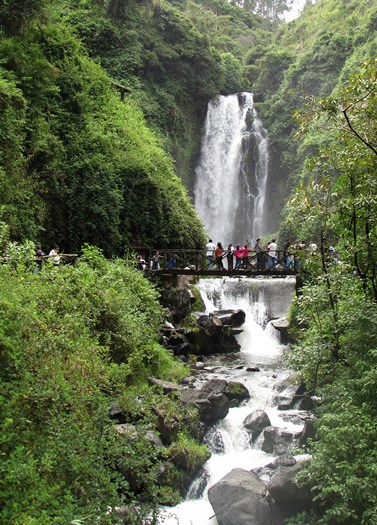
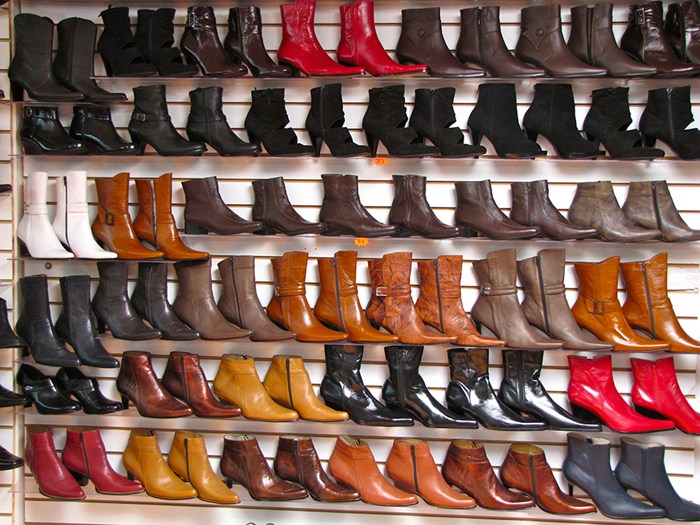
Left: You have to go well off the tourist trail to find the real beauty of Ecuador like the Peguche waterfall. Right: The shoe industry in Otavalo is the main industry.
It’s worth getting up extra-early to visit the animal market, Feria de las Animales (6-10 a.m., Saturday only), a boisterous event on the outskirts of town where vendors hawk animals large and small. From a distance, the event looks like a free for all. In fact, the setup is quite logical with large animals such as cows, horses and sheep at one end, and smaller animals such as rabbits, chickens and guinea pigs at the other.
It’s also worth a visit to the centrally-located food market — selling fruits, vegetables, seafood and meat — for an inexpensive and delicious lunch. Take a seat at one of the many small fondas and enjoy a heaping plate of succulent roasted pork accompanied by a heaping pile of hominy, beans and potato dumplings, all for $3.75 or less.
After visiting the markets in Otavalo, I was eager to explore some of the towns where crafts are produced. Located about 12 kilometres north, Cotacachi is celebrated as a centre for fine leather. It’s also a popular destination for North American expats, meaning the town is more spiffed up and pretty than Otavalo.
The sweet smell of leather permeates every shop clustered along the main streets, each offering a specialty handcrafted line of boots, jackets, belts, purses, wallets and even saddles for equestrian enthusiasts. English is spoken in most establishments so don’t be afraid to barter. (Bargaining in the markets is also permitted, if not expected.)
After shopping, there are quite a few spots where one can find a tasty lunch. I wandered into the courtyard of D’Anita Restaurant, a small family-run establishment, and enjoyed perfectly prepared grilled corvina accompanied by hand-cut fries and a broccoli salad ($14).
The small village of Peguche is home to many weavers and several shops act as co-ops for local families’ work. In Artesania El Gran Condor, you’ll find everything from rugs and wall hangings to ponchos, scarves, sweaters, shawls, children’s clothing and finger puppets. In the lower level, Luzmilla Arias de Ruiz demonstrated working on treadle and backstrap looms, and how thread is made on a spinning wheel.
Its slightly more difficult, though not impossible, to find the studio of master weaver Jose Cotacachi. (Hint: It’s hidden on a side street behind the church.) Inside, a small cheerful man weaves a variety of items on his treadle loom, including tapestries and sweaters. On my visit, Cotacachi explained that his father was a weaver and that he and his sister started leaning the craft at age 9. By 25, he was creating his own colourful and complex geometric patterns and designs based on symbols from pre-Hispanic civilizations, as well as abstract images of birds, fish, volcanoes and indigenous people in Ecuador. On a windowsill in the workroom, he keeps a piece of cactus to demonstrate how red dye is made from small insects that live on the plant.
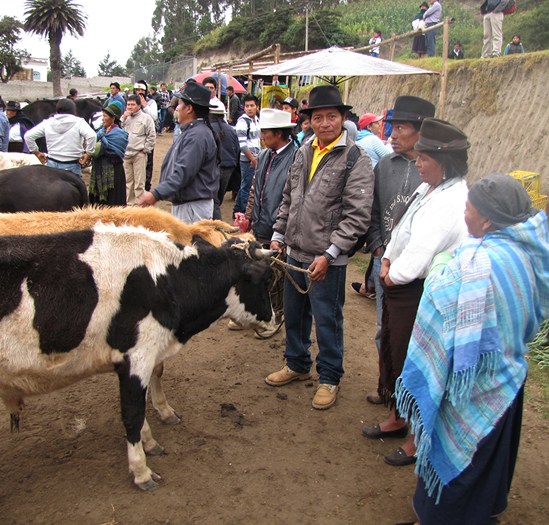
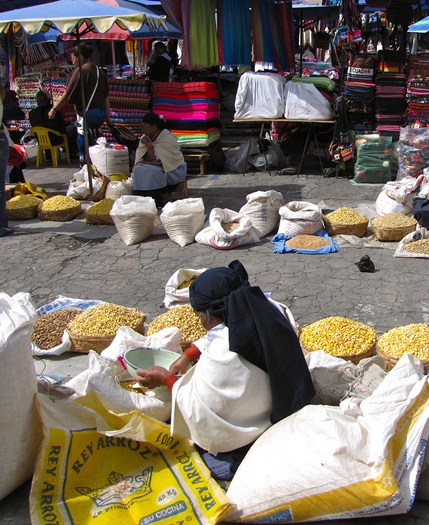
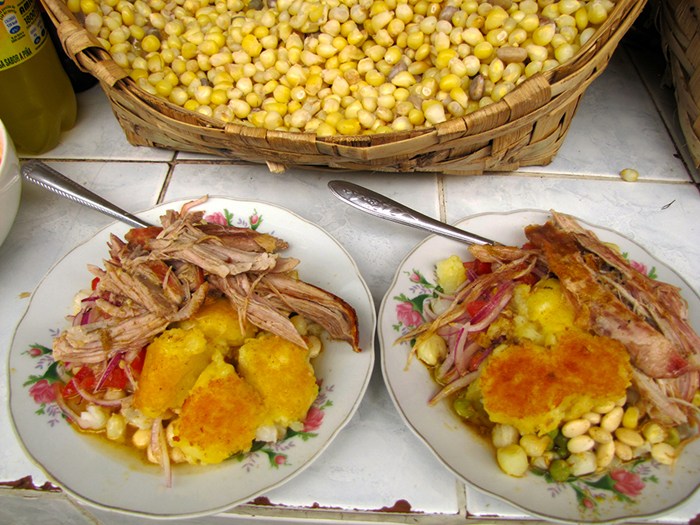
Left: You have to go well off the tourist trail to find the real beauty of Ecuador like the Peguche waterfall. Middle: Farmers arrive early at the market in Otavalo to sell their wares. Right: The market in Otavalo is full of regional treats.
After visiting the master weavers in Peguche, it’s an easy 15-minute hike through a eucalyptus forest to the Cascadas de Peguche, a site considered sacred and run by the local indigenous community. Follow the path to a sturdy bridge at the top of the 18-metre-high falls, where water rushes down from the foothills of the Imbabura volcano.
For another spectacular hike, drive to the extinct Mojanda volcano above Otavalo, where the Fuya Fuya peak looms over three mountain lakes surrounded by high-altitude grasslands called paramo. Paths around the lakes and up to the summit offer stunning views and a chance to observe more than 100 species of birds.
Eco-tourism is popular throughout the region. One of the better-known places to stay is Casa Mojanda, an Andean organic farm and hotel above Otavalo. Small cabins and family houses, all with private baths, gardens and terraces, offer views of the Imbabura and Cotacachi volcanoes and the verdant valley between. Breakfast is served daily, and prix fixe dinner is served nightly featuring produce from their gardens.
After two weeks of exploring, I was ready for sea level pursuits. Next stop, Galapagos!
Information
• Having a car is a plus but not necessary. A bus runs from Quito to Otavalo and, once there, taxis are inexpensive. / It’s best to travel with U.S. Currency. / Where to stay: Casa Mojanda Apartado 160, Otavalo. Rates $140-$420 -
www.casamojanda.com/ The hotel will arrange transportation from Quito. / For more information:
ecuador.travel/
About the Author
Necee Regis has been writing about travel, food, culture and luxury lifestyles for 15 years for publications including American Way, ShowBoats International, The Washington Post, The Boston Globe, Los Angeles Times and multiple in-flight magazines. Her special interest - some might say obsession - with the world of oysters and shucking competitions has earned her the title "Oyster Connoisseur." She has never met an oyster she didn't want to eat.